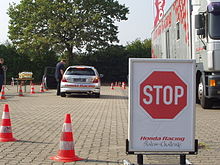Automobile slalom
Automobile slalom is the motorsport variant of slalom and is carried out on paved, level road surfaces (asphalt, concrete, etc.). It is a popular sport, which means it can also be financed by private individuals and is therefore very popular.
In an individual time trial, the participant should cover a route marked by cones and markings as quickly as possible. Knocking over the "cones" is punished by adding penalty times in the range of seconds and thus makes it more difficult to reach a leading position. Precision and a clean driving style are therefore more important than pure speed.
The start takes place standing with the engine running, the finish is crossed "on the fly" (rarely taken literally). The tasks set can be:
- single mark
- Door sequence offset to the left or right
- Pylon lane or track lane
- Sequence of markings in a line (Swiss slalom)
- half turn
- whole turn
The door width should be between 2.50 and 3.50 m.
Moving or knocking over pylons will result in time penalties, generally three seconds per error. Missing individual tasks can be penalized with 15 seconds or lead to exclusion. Each participant has a training run and two or three races available. Their times are added together, plus any penalty points. Even a single mistake - i.e. 3 penalty seconds - almost always leads to a significant loss of rank in the race.
Slalom sport in Germany takes place on the basis of different regulations, depending on the length of the route, and requires a license (DMSB slaloms) or license-free (club slaloms). In the end, anyone with a driver's license can take part; young people aged 16 and over with a DMSB license do not even need a driver's license for a car.
The DMSB regulates slaloms over 1,000 m up to a maximum of 5,000 m per race, and associations such as state motor sport associations or regional clubs of the ADAC have drawn up regulations for club slaloms up to 1,000 m (until the end of 2009 - 800 m).
In the DMSB area , vehicles are divided into the following groups:
- Group G (near-series vehicles)
- Groups
- Group F (from 2005 to the end of 2009 Group F-2005) (improved vehicles)
- Group H (greatly improved vehicles)
- Group FS (Freestyle)
- Group SE (slalom beginners)
Since this is a closed route, the vehicles in groups N, H and FS do not have to comply with the StVZO .
While the group of near-series vehicles (group G) are dominated by 3-series BMWs of the E30 model series, the Opel C-Kadets lead their group among the greatly improved vehicles. Group N plays a subordinate role in terms of the number of participating cars.
Maneuverability, a low curb weight, a good chassis and the right tires are more important than pure power (PS) for successful slalom vehicles.
Typically, parking lots, industrial areas, airfields and also race tracks are the venues. In principle, every street section can be used for a slalom.
The effort to simply ride along is comparatively low. A level C national driver license is required; this is the lowest and cheapest license. Drivers who have or will have reached the age of 16 in the competition year are permitted. The vehicle doesn't have to be new or improved. In particular, several participants may start on one car, one after the other, of course. Special safety devices (such as roll bars ) do not have to be installed, but are recommended. It is also only recommended that the driver wear fire-resistant overalls; a standardized protective helmet is sufficient. Since several events take place at different locations within Germany every weekend during the season, the journey to the route is also relatively short.
But you can also drive the technical effort higher and drive in corresponding classes with treadless slicks . A roll bar or cage has advantages, especially when welded in, because it stiffens the body and the chassis . This makes the steering behavior more precise. The regulations also allow "small" changes to the chassis and brakes in the standard classes, which have a positive effect on speed. The suitability of the vehicle for everyday use suffers as a result, so that it is easier to hunt down when towing a trailer. This is actually mandatory for Group H , in which far-reaching changes to the vehicle are allowed.
In addition to the many regional and national cups and championships, a German championship and the German racing slalom championship are announced at the national level. The latter in particular is regarded as the absolute premier class in slalom sport. Here almost always 5 km per race at an average speed of well over 100 km / h. The German racing slalom championship is held at the Hockenheimring , in Oschersleben or in Groß Dölln , among others .
Nevertheless, the slalom is the most popular form of doing or watching motorsport, with admission almost always free.


